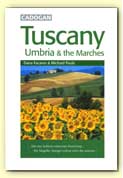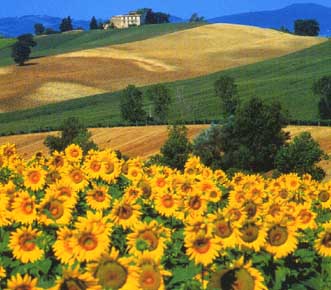 Cadagon Guide to Tuscany & Umbria
Cadagon Guide to Tuscany & Umbria
Back to Cadogan Guides Overview
Back to Guidebook Series
Browse by Region
 Cadagon Guide to Tuscany & Umbria
Cadagon Guide to Tuscany & UmbriaA glass of wine before dinner on the garden terrace, the olives glinting in the last flash of the setting sun as the geometric vineyards lose their rigid order in the melting darkness, and only the black daggers of the cypresses stand out against the first stars of the evening-where could you be but Tuscany? It needs no introduction, this famous twilit land, where Titans of art five hundred years ago copied, and then outdid nature, and where nature gets her gentle revenge by rivalling art. Its neighbour Umbria is perhaps most familiar as the land of St. Francis of Assisi, and indeed many visitors have found it a mystic place, one that 'speaks in silences.' Umbria has much in common with Tuscany-wine, art and lavish natural beauty, and the same remarkable sense of continuity, of a land and people in perfect agreement. Long over-shadowed by its neighbours, the Marches also share many of the region's best features: transcendent Renaissance art, ageless hill towns, sandy beaches and a few surprises, but enjoyed by a fraction of the visitors. This is starting to change, slowly, but if no longer a best kept secret, the Marches still offer a very seductive slice of central Italian gentility.
 Travellers have been coming to central Italy ever since the Middle Ages, to learn, to see and to understand. Most have come with the Baedekers or Ruskins or Berensons in hand, and even today it isn't easy to escape the weight of generations of worthy opinions or to avoid treading on those same old grapes of purple prose. After all, most of what we call Western civilization was either rediscovered or invented here, leaving behind works that have lost none of the power; at times it seems as if the artists of the early 1400s descended from outer space with their secret messages for the imagination. Anyway, to the mass of accumulated opinion we now add ours, for better or worse, but mostly in the hope of provoking some of your own.
Travellers have been coming to central Italy ever since the Middle Ages, to learn, to see and to understand. Most have come with the Baedekers or Ruskins or Berensons in hand, and even today it isn't easy to escape the weight of generations of worthy opinions or to avoid treading on those same old grapes of purple prose. After all, most of what we call Western civilization was either rediscovered or invented here, leaving behind works that have lost none of the power; at times it seems as if the artists of the early 1400s descended from outer space with their secret messages for the imagination. Anyway, to the mass of accumulated opinion we now add ours, for better or worse, but mostly in the hope of provoking some of your own.
But at the end of the day-or as we are, at the twilight of the 20th century, when times seem to be changing faster than we can or care to-the enduring charm of Tuscany, Umbria and the Marches is in that dreamy glass of wine, in those hills that look exactly as they did when Piero painted them, in the bartender who's a dead ringer for Lorenzo de' Medici, in those bewitching Etruscan smiles that seem to have been smiled only yesterday. Things have stayed the same way for centuries not by any accident, or economic reason, or by divine decree of some Tuscan National Trust, but because that's the way people like them. People here make as few concessions to the 20th century as possible, and their Brigadoon may not be for everyone. They're not catching up with the world; the world's catching up with them.